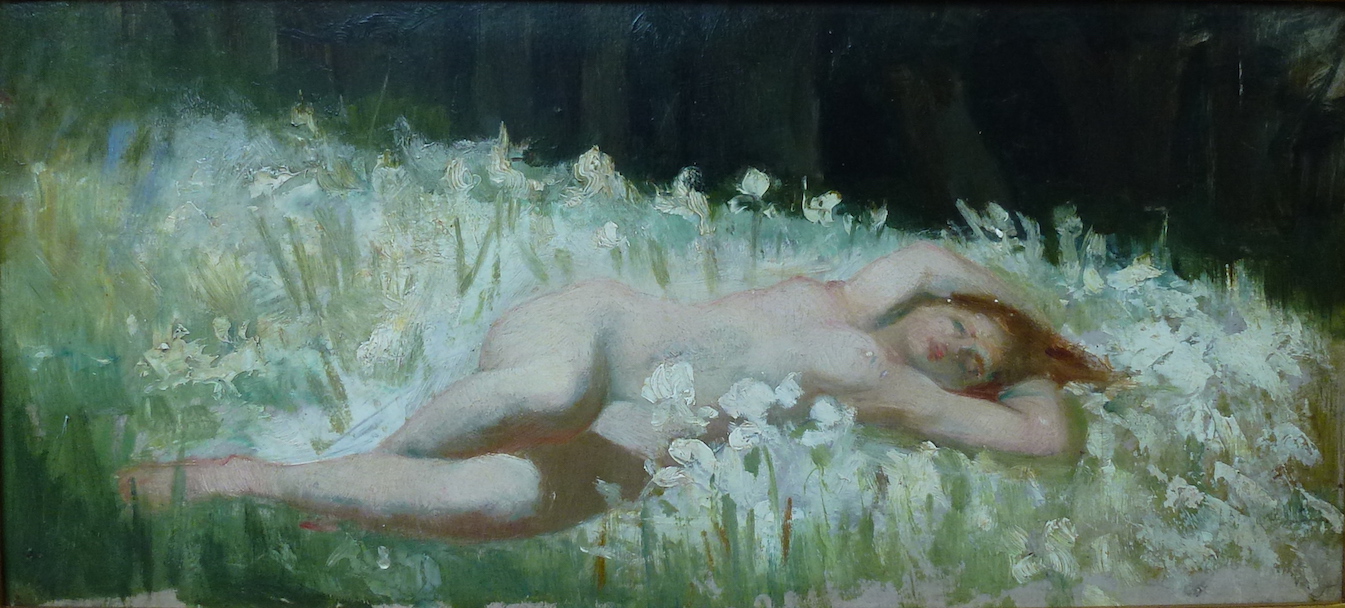Study for Fleur de Lys
Charles Douglas Richardson

Details
- Artist
- Charles Douglas Richardson
- Title
- Study for Fleur de Lys
- Medium
- oil on artist board
- Size
- 21 x 46 cm
- Details
Sold This artwork has been sold. Please contact us for similar artworks.
Further Information
Charles Douglas Richardson is one of the more complex and fugitive late nineteenth century Melbourne artists, particularly as many of his artworks, ranging across a number of media, from watercolour to sculpture, and with a diverse subject matter, from academic to neo-classical, are now only known by photographs. This makes him rather elusive in terms of knowledge of his working practices and in placing him in the context of his peers, although he was acclaimed by critics of the day.
This accomplished and beautiful unsigned nineteenth century painting has a direct – if not fully quantiable – relationship to Richardson, as it represents a variant image of his major work, Fleur de Lys, 1890, (National Gallery of Victoria, illustrated here). Whether a preparatory sketch or an image made after the original is difficult to ascertain, as there is no annotation or other supporting documentation associated with the work. Given that Fleur de Lys was sold from his studio¹, before its presentation at the Victorian Artists Society in 1890 (to where it was loaned by the purchaser), the latter scenario is also plausible.² It could also be a preparatory piece for the larger work, with the reclining figure set on a bed of irises in a wider landscape vista with a forest of tree trunks in the background, in comparison to the more abstracted setting of the large work.³ Currently no oil sketches
for fullscale works have been documented in Richardson’s publicly known oeuvre.4 However, a drawing in the National Gallery of Victoria has been considered by the author and other respected opinions, to bear an affinity with Fleur de Lys. Whilst presenting a maturer and slightly more down to earth iteration of the figure, as well as some difference of the pose,5 this small oil sketch is closer to the large work in design.
The handling of colour and light presents a particularly plausible link to Richardson’s hand. Elements such as the luminosity of the central gure against the danker, darker borders and outer margins of the picture plane, the arbitrary, imaginative treatment of light, like a theatrical spotlight, are consistent throughout his gurative oils. Likewise the pastel oral colours and generally clear and bright tonalities resonate with Richardson’s surviving imaginative works. The luscious floral detailing framing the figure is a motif often seen in Richardson’s art. In 1890 Table Talk commented that “Fleur-de-lys reveals a young goddess reclining, amidst the flowers which surround her and completely fill the canvas, to give the impression that the feur-de-lys is the principal subject and not the goddess.”6 The overall directness and confidence of the small sketch matches the clarity, liveliness and freshness of the completed Fleur de Lys, a work that reads more as avant garde than academic. Together with the more literary Acrasia or the Enchanted Bower 1889, Art Gallery of South Australia, Fleur de Lys marks the high point of Richardson’s known gurative paintings. The assured handling of the forms and volumes of the figure and the flowers again directly mirrors the totality of Richardson’s achievement in Fleur de Lys, suggesting that the works are linked.
Juliette Peers
¹. Table Talk 17 Jan 1890 p. 8
². Perhaps it is a sketch the artist made for himself on selling the painting or for a friend or associate who admired the work and wanted a record before it disappeared into private hands in an era before our own when photographic or digital images of paintings are readily exchanged and distributed.
³. A third possibility it that is was painted by a colleague or even a student. A direct copy of an 1888 work by Florence Fuller signed by a Melbourne-based student of hers is known from about the c.1890 period suggesting that copying – a longstanding practice in Europe since the Renaissance - was an accepted manner of art education at that period. Victor Brun, an Italian-Australian artist working in Melbourne around the turn of the century also taught pupils via this practice. No known documentation suggests that Richardson taught in that manner and this theory also begs another question as to the identity of the artist.
4. Studies exist for major works by both Roberts and Streeton, from the 1880s-1890s period to whom Richardson was then professionally and personally close, in fact having shared studios at di erent stages with both artists. Building up important works via preparatory studies was an accepted practice in Melbourne plein air circles.
5. Although currently dated c.1880, the work with chalk highlights and on a tinted paper is not the standard student life class drawing as are the other two works that were acquired with it.
6 . Table Talk 17 Jan 1890 p. 8 There is at least one known photograph attributed to Richardson which also seeks to set up this conjunction of flowers and the female body in a live outdoor scenario.
